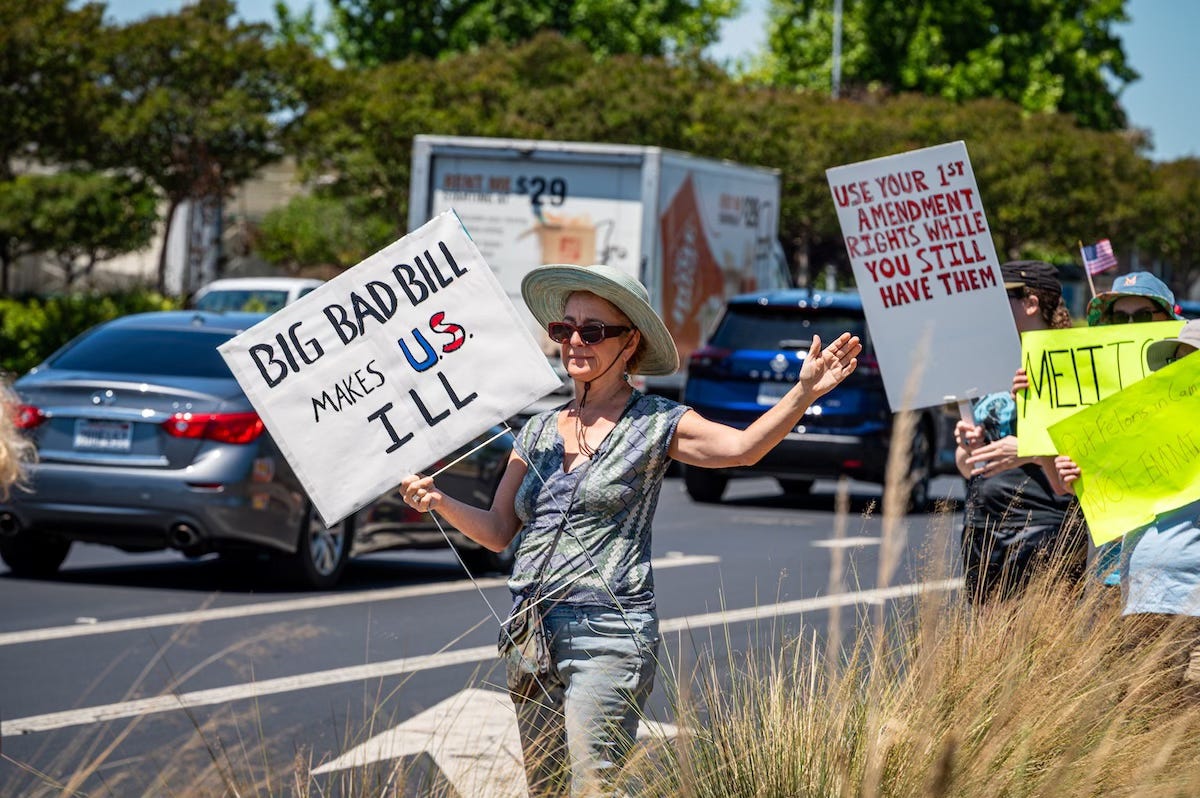Five Ways Trump's "Big Beautiful Bill" Will Hurt Americans
The high price of a bill that puts the rich first.
It's not often that a single piece of legislation can reshape an entire country's future in just under 1,000 pages. But Trump's "One Big Beautiful Bill"—now signed into law—does exactly that. The bill will deliver the largest transfer of wealth from regular people to the rich in modern American history, while gutting programs and industries that will power our nation’s future. Here are the top five ways this bill will harm ordinary Americans.
1. Millions Will Lose Their Health Coverage
The single biggest cut in the bill targets Medicaid and the Affordable Care Act, slashing over $1 trillion in federal funding for healthcare. According to the Kaiser Family Foundation, up to 17 million Americans may lose their health insurance. These are not just numbers: losing insurance means unaffordable prescriptions, missing checkups, and more expensive care, meaning Americans may face bankruptcy for getting sick.
Rural America already faces a healthcare crisis: over 300 rural hospitals are at "immediate risk" of closure. The bill's Medicaid cuts could accelerate this collapse. When rural hospitals close, they don't just eliminate healthcare access; they also often take down the community's largest employer.
2. Killing Clean Energy Jobs and Raising Energy Prices
The bill slashes all major tax credits for wind power, solar energy, and electric vehicles, effectively ending America's clean energy boom. Industry analysts warn these cuts will destroy more than 830,000 clean energy jobs and slow investment in renewables.
The economic pain doesn't end there: demand for electricity is rising fast due to data centers and AI, and currently, wind and solar are the fastest-growing energy sources that meet that demand. The new law is projected to raise electric rates by about 50% by 2035—we'll have dirtier electricity, and pay more for it. Meanwhile, we are badly damaging our domestic solar and battery manufacturing industries just as they were hitting their stride, essentially handing China permanent dominance in the most important growth sector of the 21st century. These industries were finally gaining momentum—factories were opening, jobs were being created, and America was positioning itself to compete globally. Now we're pulling the rug out from under them right when they needed support most.
3. Permanent Tax Cuts for the Rich
At the core of the bill is a massive permanent extension of Trump's 2017 tax cuts, which are overwhelmingly skewed toward the wealthy. The top 1% get an average annual tax cut of $61,000, while working families lose more in benefits than they gain in tax relief. A single parent earning $20,000 might save $750 in taxes but lose $1,600 in benefits—a net loss of $850. This is a deliberate and unprecedented transfer of wealth from working families to the very richest among us.
This is not what prosperity looks like for ordinary Americans. Trump's bill helps one group—the rich—while leaving the rest of us with lost healthcare, higher energy costs, fewer jobs, slower economic growth, and a massive pile of debt.
4. Higher Interest Rates, Slower Growth
Coupled with the deep cuts to healthcare, food aid, and education, the bill's tax cuts for the rich are so costly that the U.S. will have to borrow an extra $3.4 trillion over the next decade. That surge in federal borrowing will drive up interest rates for everyone—whether you're buying a home, a car, or carrying a credit card balance.
What's worse, independent economic analysis shows this massive borrowing will actually shrink the economy over time. Yale's Budget Lab found that by 2054, the U.S. economy would be 2.9% smaller than it would be without the bill. Not only do the tax cuts not pay for themselves—they make Americans poorer in the long run.
5. Making Student Loans More Expensive
This bill will be a disaster for Americans who are planning on graduate school or are already repaying student loans. It will eliminate the SAVE plan that 8 million borrowers use for affordable payments, end deferment for unemployment, and strip away income-driven repayment options for parent borrowers.
A typical loan recipient with a college degree and an annual income of $80,300 will pay an additional $2,929 per year under the new rules, kneecapping recent graduates as they get a foothold in the workforce. The bill also caps graduate borrowing at $100,000—far below the true cost at many institutions, forcing students into expensive private loans with fewer protections.
This bill does not help the majority of Americans. Send a message to this administration and become a subscriber today.



